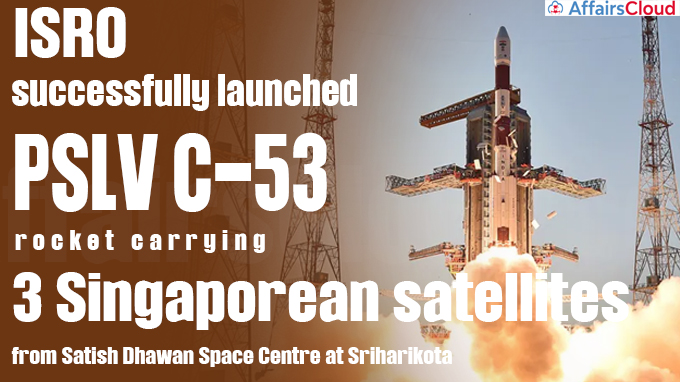
On June 30, 2022, the Indian Space Research Organisation (ISRO), India’s national space agency, successfully launched Polar Satellite Launch Vehicle (PSLV)-C53 (PSLV-C53), carrying 3 Singaporean satellites: DS-EO, NeuSAR, and SCOOB-1, into an intended orbit at an altitude of 570 kilometres (km) measured from the equator, with a low inclination of 10 degrees.
PSLV-C53/DS-EO is the second dedicated commercial mission of NewSpace India Limited (NSIL), the commercial branch of the Department of Space (DOS), ISRO, and is launched from the Satish Dhawan Space Centre’s second launch pad spaceport in Sriharikota, Andhra Pradesh.
Backdrop
Earlier on June 23, 2022, NSIL has launched Geosynchronous Satellite (GSAT)-24 (GSAT-24), the first dedicated mission, in its first “demand-driven” communication satellite mission onboard the Arinave-V rocket from French Guiana.
- Following space sector reforms, it was launched, with the whole capacity on board leased to Direct-to-Home (DTH) service provider Tata Play.
Note: PSLV is called the workhorse of ISRO. It had successfully launched two spacecraft – Chandrayaan-1 in 2008 and Mars Orbiter Spacecraft in 2013 – that later travelled to Moon and Mars respectively.
PSLV-C53/DS-EO Mission
i. PSLV-C53/DS-EO Missionis designed to orbit DS-EO satellite along withtwo other co-passenger satellites from ST Electronics,
- This is the 55th PSLV mission and the 15th mission using the PSLV-Core Alone variant.
- It is the 16th PSLV launch from the second launch pad.
ii.The mission intends to demonstrate the use of the spent upper stage of the launch vehicle as a stabilised platform for scientific payloads following satellite separation.
iii. PSLV-C53 is a four-stage launch vehicle which is 44.4 m tall and has a lift-off mass of 228.433 tonnes.
iv.After the 3 Singaporean satellites were launched, the PS4, or fourth stage of the PSLV, was converted into the PSLV Orbital Experimental Module (POEM), an orbital platform for conducting in-orbit scientific experiments.
- The PS4 stage was orbiting the Earth for the first time as a stabilised platform, demonstrating the viability of ISRO’s proposal to employ the rocket engine’s fourth and final stage further into space.
v.POEM was carrying six payloads, including those from two Indian space start-ups — Dhruva Space Private Limited in Hyderabad (Telangana) and Digantara Research and Technologies Private Limited in Bengaluru (Karnataka)– enabled through Indian Space Promotion and Authorisation Centre (IN-SPACe)and NSIL.
- Dhruva Space & Digantara are the first set of space start-ups to receive the authorization, signalling the commencement of private space sector launches in India.
The 3 Singaporean Satellites
i. DS-EO, a 365 (kilogram) kg satellite, and NeuSAR, a 155 kg satellite, both belonged to Singapore and were built by Starec Initiative of the Republic of Korea.
- It carries an Electro-Optic, multi-spectral payload that will provide full colour images for land classification, and serve Humanitarian Assistance and Disaster Relief (HADR) needs.
ii.NeuSAR is the first small commercial satellite from Singapore with a Synthetic-Aperture Radar (SAR)payload that can capture imagesin day and night and under all weather conditions.
iii. Scoob-1, a 2.8 kg satellite of Nanyang Technological University (NTU), Singapore.
- It is the first satellite in the Student Satellite Series (S3-I), a hands-on student training program from the Satellite Research Centre (SaRC) at Singapore’s NTU School of Electrical and Electronic Engineering.
About Indian Space Research Organisation (ISRO):
Chairman – S. Somanath
Establishment – 1969
Headquarters – Bengaluru, Karnataka




